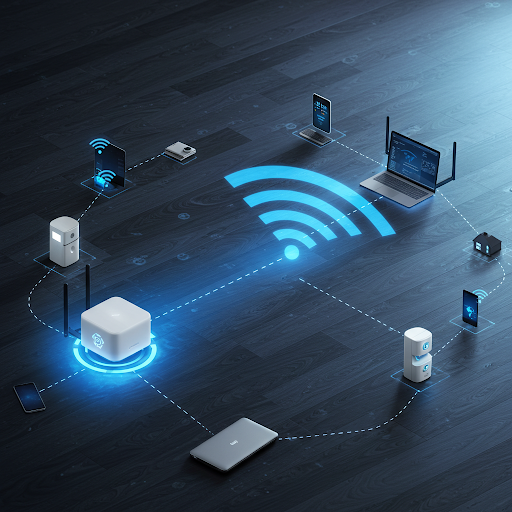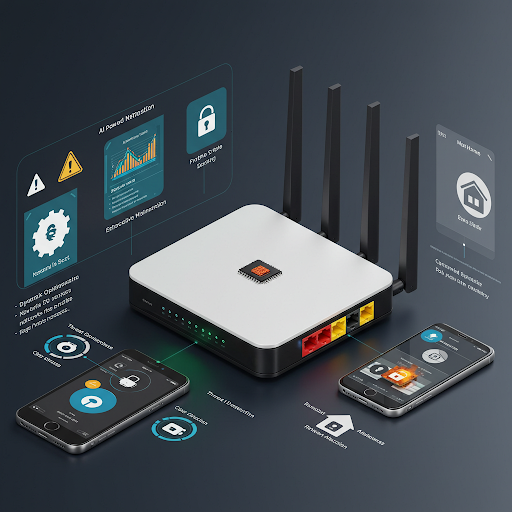In 2025, WiFi connectivity will look remarkably different than it does today. New standards like WiFi 7 and 8 will enable multi-gigabit speeds, while AI integration will optimize performance and security. What can we expect from WiFi in the next few years? This article explores the key innovations that will shape the future of wireless connectivity.
 |
| The Future of WiFi: Exploring Cutting-Edge Technologies and Trends in 2025 |
Next-Generation WiFi Standards: Faster, Broader, and More Reliable
WiFi standards are continually evolving to meet growing demands. Two major upgrades on the horizon are WiFi 7 and 8, promising huge leaps in bandwidth, coverage, and reliability.
WiFi 7 Paves the Way for Widespread Multi-Gigabit Connectivity
WiFi 7, also known as IEEE 802.11be, is slated for release in 2024. It will utilize previously unused spectrum in the 6 GHz band to achieve:
- Multi-gigabit speeds: Peak rates up to 30 Gbps, with typical speeds above 2 Gbps—10x faster than WiFi 6.
- Lower latency: Up to 2x reduction in round-trip latency.
- Expanded capacity: More available channels reduces congestion in dense deployments.
For enterprises, WiFi 7 enables next-gen applications like high-res AR/VR collaboration and rapid sharing of huge files. Consumers gain lightning-fast gaming and streaming.
To reap these benefits, organizations should begin WiFi 7 upgrade planning in 2023 to ensure a smooth transition. A staged rollout prioritizing high-traffic areas is recommended.
WiFi 8 Promises Wireless Connectivity Upwards of 100 Gbps
Looking even further ahead, WiFi 8 (802.11bx) aims to deliver speeds exceeding 100 Gbps. This will become possible through:
- Native support for 320 MHz-wide channels.
- Multi-link operation (MLO) using multiple bands simultaneously.
- Advancements in multi-user MIMO, 4096-QAM modulation, and intelligent traffic coordination.
While the WiFi 8 standard isn't expected until 2026, enterprises can prepare by deploying flexible, software-upgradable WiFi 7 access points. This will simplify the eventual transition.
Optimizing Spectrum Access is Critical
To fully leverage emerging standards, adequate spectrum availability is crucial. Key developments include:
- 6 GHz adoption: The FCC opened the 6 GHz band for WiFi use in 2020. WiFi 7 will be the first standard to tap into this bandwidth, adding up to seven new 160 MHz channels.
- Millimeter wave (mmWave) integration: mmWave bands above 24 GHz offer massive amounts of virgin spectrum for ultra-high throughput. Seamless mmWave integration remains an ongoing challenge.
- Automated frequency coordination: AI will optimize spectrum allocation among access points to minimize interference and congestion. This ensures optimal performance.
 |
| Next-Generation WiFi Standards: Faster, Broader, and More Reliable |
AI-Powered WiFi for Smarter, Safer Networking
Integrating AI and machine learning will be critical for managing the complexity of next-gen WiFi networks. In 2025, expect AI to enhance all aspects of wireless connectivity:
Network Intelligence Optimizes Performance
AI will provide unprecedented visibility into WiFi environments, enabling:
- Dynamic optimization: APs self-tune based on real-time user demand and interference conditions. This provides the best possible performance.
- Predictive maintenance: Machine learning detects anomalies and forecasts issues before they arise. This allows for preventative maintenance.
- Self-healing networks: When problems occur, AI guides APs to instantly adjust configurations and routing to minimize disruption.
For instance, a school district deployed an AI-based WiFi system which reduced trouble tickets by 92% and boosted Internet speeds by 36%.
Enhanced Security Through Automation
AI and automation will also bolster WiFi security:
- Threat detection: Machine learning identifies IoT anomalies, suspicious traffic patterns, and zero-day attacks. This flags threats early for rapid response.
- Automated response: Software agents can quarantine devices, adapt access rules, or redirect traffic to isolate attacks—without any human input.
- User profiling: AI classifies traffic by user role and intent to detect insider threats. For example, unusual after-hours activity by an employee could trigger alerts.
According to Fortinet, integrating AI into WiFi security reduces breach costs by $3.75 million on average.
Personalized User Experiences
In 2025, AI will enable WiFi networks to optimize experiences for each individual user:
- Context awareness: APs will continuously scan user activity and environments to build detailed context profiles. This allows for personalized optimization.
- Role-based allocation: The network assigns resources dynamically based on user needs. A video editor may get priority bandwidth over basic web browsing, for instance.
- Predictive caching: AI models will forecast users' content needs to cache relevant data proactively. This lowers latency and enhances mobility.
As an example, a Las Vegas resort embedded AI in its WiFi network to tailor guest experiences. It increased customer satisfaction scores 22% in 6 months.
 |
| AI-Powered WiFi for Smarter, Safer Networking |
Seamless Convergence for Ubiquitous Connectivity
With users connecting through a growing array of bands (2.4/5/6 GHz WiFi, 4G/5G cellular), delivering universal connectivity will require systems that converge these technologies:
OpenRoaming Enables Seamless Handoff Between Networks
OpenRoaming standards will allow devices to migrate smoothly between WiFi and cellular networks. Authenticating once grants secure access to any participating hotspot or cellular network globally.
Enterprises should implement OpenRoaming for:
- Continuous connectivity across locations.
- Reduced sign-in friction for users.
- Roaming agreements with national wireless carriers.
Multi-Link Operation Boosts Throughput and Reliability
Another major innovation is multi-link operation (MLO) which bonds multiple bands simultaneously. For example, combining three WiFi radios can triple throughput. Additional benefits include:
- Redundancy if one link fails, preventing drops.
- Load balancing across bands to prevent congestion.
- Maximizing performance for each client device.
In trials by the Wireless Broadband Alliance, MLO achieved up to a 3x increase in average data rates.
Scalable WiFi Infrastructure for the IoT Revolution
WiFi will also serve as the wireless fabric for IoT deployments. WiFi HaLow offers long-range, low-power connectivity for sensors and wearables. WiFi EasyMesh delivers optimized multi-AP coverage.
AI-enabled management systems will automate device onboarding and monitoring. Enterprises should invest in centralized, cloud-based control platforms with full API integration capabilities to scale massive IoT fleets.
 |
| Seamless Convergence for Ubiquitous Connectivity |
Emerging Use Cases: From Smart Cities to AR/VR Worlds
WiFi innovation will support exciting new applications from immersive tech to autonomous transportation:
Immersive Experiences Require Ultra Low Latency
By 2025, advanced AR/VR/XR experiences will demand highly responsive wireless connectivity:
- Multi-gigabit throughput to stream uncompressed 8K 360° video feeds.
- Sub-5ms latency for real-time rendering and interaction.
- Seamless handoff between APs across large areas.
Dallas Fort Worth airport deployed WiFi 6 to enable historic aircraft AR experiences with zero lag or buffering for users.
Smart Cities Run on AI-Optimized WiFi Infrastructure
Ubiquitous, high-capacity WiFi will also catalyze smart city innovation:
- HD security surveillance: High-density WiFi with failover supports thousands of real-time video streams.
- Autonomous transit: Self-driving city buses and taxis ingest live WiFi sensor data for navigation.
- Environmental monitoring: A mesh of WiFi-connected pollution/noise sensors enable real-time status dashboards.
In Las Vegas, Cisco partners with the city to analyze WiFi data from 30M annual tourists for traffic optimization, safety, and infrastructure planning.
Edge Computing Reliant on Distributed WiFi
Latency-sensitive apps like multiplayer VR, robotics, and autonomous vehicles will require distributed AI compute power. WiFi 7’s multi-gigabit bandwidth can interconnect edge microdata centers.
Scalable WiFi infrastructure with built-in support for low-power AI will enable innovative use cases we can’t yet imagine. The future of wireless connectivity is bright.
 |
| Emerging Use Cases: From Smart Cities to AR/VR Worlds |
Frequently Asked Questions
What industries will benefit most from WiFi 7/8?
WiFi 7 and 8 will broadly impact sectors like:
- Healthcare: Faster transfers of medical imaging and remote surgery with minimal latency.
- Education: Smooth 4K+ video streaming for remote students.
- Retail: Next-gen digital signage and VR product demos.
- Manufacturing: Secure OT connectivity and preventive maintenance via IIoT sensors.
How can small businesses upgrade affordably?
Invest in equipment that supports modular/software upgrades like:
- Cloud-managed APs: These allow remote firmware updates to enable new capabilities.
- SD-WAN routers: They simplify adding multiple WAN links for greater throughput and redundancy.
Avoid proprietary systems without upgrade paths. The DIY eero Pro mesh kit is a good budget-friendly WiFi 6 option.
Will WiFi replace 5G cellular technology?
WiFi and cellular remain complementary technologies. WiFi offers high bandwidth for fixed locations, while cellular excels at mobility.
With innovations like OpenRoaming for converged access, easy roaming between networks, and multi-link bonding to combine speeds, WiFi plus 5G will unlock the best overall connected experiences.
Conclusion
The WiFi landscape will look vastly different by 2025 thanks to next-gen standards like WiFi 7 and 8. AI integration will optimize all aspects of wireless performance, security, and efficiency. And convergence with cellular will enable ubiquitous connectivity.
Organizations that invest strategically in upgradable infrastructure and begin planning around innovations like OpenRoaming and multi-link operation will have a competitive edge. With the right WiFi foundation, businesses can build digitally driven experiences and smart environments that were previously impossible.
Have questions about preparing your business or home WiFi network for the future? Drop them in the comments below!








0 Comments